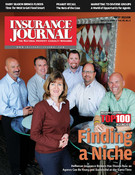Why Agencies Should Track Source to Sale
There’s one question I consistently hear from agencies of all sizes: “Can you give me ideas to make my phone ring more often?”
When I hear it, it tells me right away that an agent wrongly associates sales activity with actual sales. Phone calls generate no revenue; they actually cost an agency money. It’s only when an opportunity is converted to a sale that the agency produces any revenue.
An agency’s goal shouldn’t be to make the phone ring, it should be to maximize its sales. But how? It all starts with tracking “source to sale.”
Many agents do some form of source to sale tracking, but few track the items necessary to understand their sales efficiency. Many agents track where their sales are coming from, but not in relationship to what their close rate is. Think about it this way: If an agency had two sources to sale and both generated an average of 10 policies every month, the agency probably wouldn’t prefer one over another, would it?
But what if I said that one source resulted from 100 quotes and the other from 20 quotes? That would mean the agency has a 10 percent close rate with one source, while the other has a 50 percent close rate. Clearly, the second is more preferable.
To understand these differences, agencies not only need to track sales, but also the quotes that aren’t converted to sales. To do this, start by asking four questions:
- What are the agency’s primary sources of new business?
- What are the close rates for each of the sources?
- How many policies does the agency typically sell a client that comes through each source?
- What would be the outcome of driving 100 quotes through each source?
Place answers in a grid like the one shown below. In the example, notice the differences in actual policies sold. Referrals are almost guaranteed sales opportunities with a close rate of 90 percent and typically generate two to three policies per client sold. Compare that with Internet leads, where the close rate is 5 percent and typically only one policy per sale. That means if both sources had the same 100 sales opportunities, referrals will generate 180 to 270 policies sold while Internet leads will generate only five polices sold.
Time Wasted
This is the “WOT Factor,” which stands for Waste of Time. It’s how to define the act of quoting someone and not selling them. Agencies might use the term “free quote” in an advertisement, but there’s no such thing.
Some argue that referrals are harder to get than other methods of drumming up new business. That’s true, but my point is that one only needs three quotes to produce the same amount of sales that 100 quotes would through Internet leads.
I’m not arguing agents should never invest in or pursue other sources of new business outside of the traditional. Agents should simply make their investments in time and marketing dollars reflect their expected return. It’s not unusual for many agents to spend thousands of dollars in marketing efforts like advertising, direct mail or Internet lead generation. But agents should maximize that spending on the best sources of new business.
Maximizing sales efficiency is an old concept. But I’m finding it harder for many to adhere to it for two main reasons.
First, the soft market has dried up traditional sources of new business to which many agents have grown accustomed. The vast majority of agents say referrals have always been their best source of new business, yet they lack a plan to maximize them for the agency. Many don’t even ask for referrals on a routine basis. So when the phone starts ringing less, they instinctively look for ways to make it ring more, which leads us to the second reason why many agents lose focus on sales efficiency.
There are just so many tools out there to drive leads and quotes into an agency. From direct mail lists to Internet lead generation, all of these resources are extremely accessible and appear economical, but may only be efficient sources of new business to agents that fit a certain profile.
Agents who want to do something differently in the soft market, should consider doing the basics better first – like maximizing their agency’s sales efficiency.
Was this article valuable?
Here are more articles you may enjoy.


 Soccer Officials Arrested After Melee That Damaged Hard Rock Stadium in Miami
Soccer Officials Arrested After Melee That Damaged Hard Rock Stadium in Miami  Deere Retreats From Diversity Measures After Online Attacks
Deere Retreats From Diversity Measures After Online Attacks  Global Tech Outage Disrupts Industries, Highlights Online Risks
Global Tech Outage Disrupts Industries, Highlights Online Risks  Allstate Reports Second Quarter Pretax Catastrophe Losses of $2.1B
Allstate Reports Second Quarter Pretax Catastrophe Losses of $2.1B 


